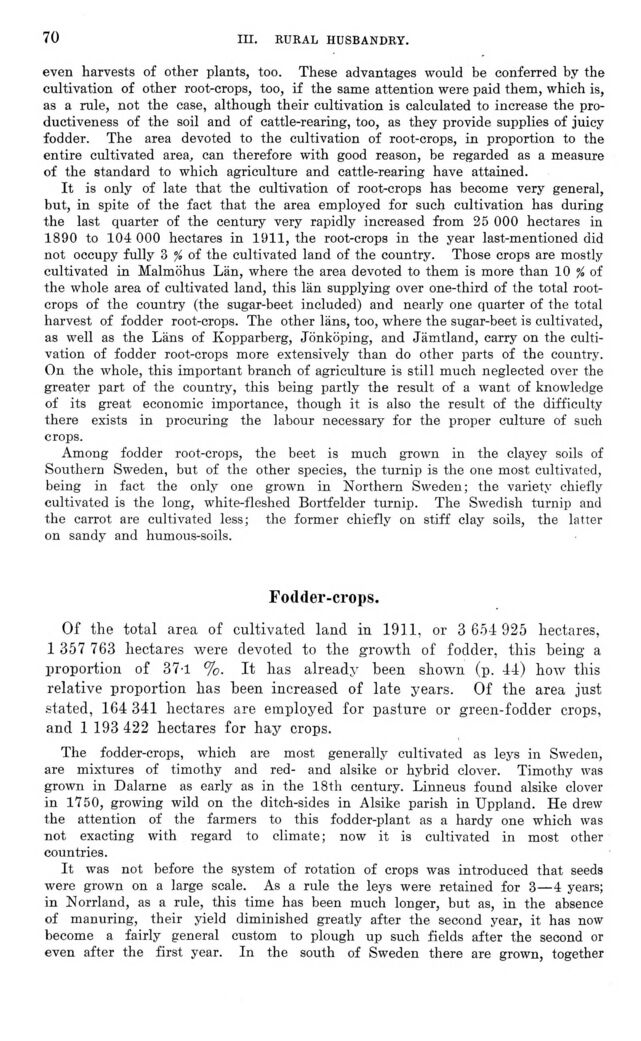
Full resolution (JPEG) - On this page / på denna sida - III. Rural Husbandry. Introd. by H. Juhlin Dannfelt - 1. Agriculture. By H. Juhlin Dannfelt

<< prev. page << föreg. sida << >> nästa sida >> next page >>
Below is the raw OCR text
from the above scanned image.
Do you see an error? Proofread the page now!
Här nedan syns maskintolkade texten från faksimilbilden ovan.
Ser du något fel? Korrekturläs sidan nu!
This page has never been proofread. / Denna sida har aldrig korrekturlästs.
70
iii. rural husbandry.
even harvests of other plants, too. These advantages would be conferred by the
cultivation of other root-crops, too, if the same attention were paid them, which is,
as a rule, not the case, although their cultivation is calculated to increase the
productiveness of the soil and of cattle-rearing, too, as they provide supplies of juicy
fodder. The area devoted to the cultivation of root-crops, in proportion to the
entire cultivated area, can therefore with good reason, be regarded as a measure
of the standard to which agriculture and cattle-rearing have attained.
It is only of låte that the cultivation of root-crops has become very general,
but, in spite of the fact that the area employed for such cultivation has during
the last quarter of the century very rapidly increased from 25 000 hectares in
1890 to 104 000 hectares in 1911, the root-crops in the year last-mentioned did
not occupy fully 3 % of the cultivated land of the country. Those crops are mostly
cultivated in Malmöhus Län, where the area devoted to them is more than 10 % of
the whole area of cultivated land, this län supplying over one-third of the total
root-crops of the country (the sugar-beet included) and nearly one quarter of the total
harvest of fodder root-crops. The other läns, too, where the sugar-beet is cultivated,
as well as the Läns of Kopparberg, Jönköping, and Jämtland, carry on the
cultivation of fodder root-crops more extensively than do other parts of the country.
On the whole, this important branch of agriculture is still much neglected over the
greater part of the country, this being partly the result of a want of knowledge
of its great economic importance, though it is also the result of the difficulty
there exists in procuring the labour necessary for the proper culture of such
crops.
Among fodder root-crops, the beet is much grown in the clayey soils of
Southern Sweden, but of the other species, the turnip is the one most cultivated,
being in fact the only one grown in Northern Sweden; the variety chiefly
cultivated is the long, white-fleshed Bortfelder turnip. The Swedish turnip and
the carrot are cultivated less; the former chiefly on stiff clay soils, the latter
on sandy and humous-soils.
Fodder-crops.
Of the total area of cultivated land in 1911, or 3 G54 925 hectares,
1 357 763 hectares were devoted to the growth of fodder, this being a
proportion of 37-1 %. It has already been shown (p. 44) how this
relative proportion has been increased of låte years. Of the area just
stated, 164 341 hectares are employed for pasture or green-fodder crops,
and 1 193 422 hectares for hay crops.
The fodder-crops, which are most generally cultivated as leys in Sweden,
are mixtures of timothy and red- and alsike or hybrid clover. Timothy was
grown in Dalarne as early as in the 18th century. Linneus found alsike clover
in 1750, growing wild on the ditch-sides in Alsike parish in Uppland. He drew
the attention of the farmers to this fodder-plant as a hardy one which was
not exacting with regard to climate; now it is cultivated in most other
countries.
It was not before the system of rotation of crops was introduced that seeds
were grown on a large scale. As a rule the leys were retained for 3—4 years;
in Norrland, as a rule, this time has been much longer, but as, in the absence
of manuring, their yield diminished greatly after the second year, it has now
become a fairly general custom to plough up such fields after the second or
even after the first year. In the south of Sweden there are grown, together
<< prev. page << föreg. sida << >> nästa sida >> next page >>